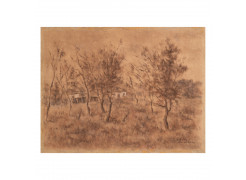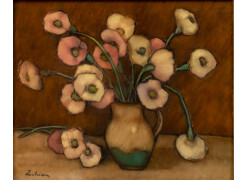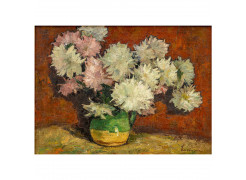Additional info:
Ștefan Luchian is one of those rare artists whose biography has evolved into myth, and whose oeuvre has acquired the aura of cultural relic. Widely acknowledged today as a foundational figure of Romanian modernism, Luchian occupies a unique place in both the national canon and the collective imagination of art lovers and specialists alike. While not severed from the classical legacy of the 19th century, his painting marks a decisive break with the dominant agrarian aesthetics of his time and inaugurates a new sensibility - introspective, synthetic, and fundamentally modern. Luchian’s floral compositions - chrysanthemums, anemones, roses - transcend the conventional boundaries of still life. They may be regarded as symbolic self-portraits or affective journals of a life shaped by seclusion and physical decay but also animated by an unbroken creative impulse. Over the past decades, these works have been described by art historians as “relic-paintings”, a term that captures not only their emotional intensity but also their role as repositories of the artist’s life and suffering. In the final phase of his artistic career, Luchian consolidated a visual idiom that is both distinctive and highly personal: an almost cloisonné-like contouring, vibrant coloration often bordering on the incandescent, and compositional simplicity that imbues the paintings with both monumentality and lyricism. His brushwork in these late works oscillates between restraint and expressive fervor, offering a chromatic tension that reveals the urgency of creation in the face of bodily collapse. The legend of Luchian was constructed not solely through his art but also through the narrative of his life. Since the early 20th century, critics and historians have framed his figure through the lens of martyrdom, sanctifying his persona as the “saint of Romanian painting.” This myth was notably reinforced by Oscar Walter Cisek, who in 1928 drew a powerful and seductive parallel with Vincent van Gogh. Cisek not only compared the two painters but even reversed the analogy, suggesting that Van Gogh was, in some sense, a Western counterpart to Luchian. This rhetorical gesture embedded the Romanian artist within the broader framework of European modernist mythology, laying the foundation for a lasting art-historical hagiography. Over time, this affective overinvestment has generated a series of enduring stereotypes: the impoverished, isolated, and ailing painter whose physical infirmity became the crucible of artistic genius. Biographical detail—his fragile physique, social withdrawal, and heroic resistance to illness—was repeatedly foregrounded in monographs and commemorative exhibitions, from the foundational texts of Virgil Cioflec to the more institutional narratives of the 20th and 21st centuries. Within this interpretive framework, Luchian’s flowers have been read as metaphors of pain sublimated into beauty, as visual hymns to a life consumed in the name of art. To stand before a painting by Ștefan Luchian is thus to engage not only with a work of exceptional aesthetic value, but also with a potent site of memory and identity. His oeuvre operates on the threshold between the visible and the symbolic, between personal suffering and collective recognition. In the terms proposed by sociologist Nathalie Heinich, Luchian’s work participates in a process of “glorification”, whereby the artist’s status transcends the field of aesthetic appreciation and enters the domain of cultural significance. Today, as the art market continues to seek authenticity, affect, and symbolic capital, the works of Ștefan Luchian stand as enduring testaments to a rare convergence of artistic mastery and human resilience. Painter of flowers, indeed—but also painter of the ineffable, the intimate, and the eternal.
-
Chant Avedissian
Cairo, Egypt, 1951 - Cairo, Egypt, 2018 -
Maria Bordeanu
b. Bucharest, Romania, 1982 -
Man Ray
Philadelphia, United States, 1890 - Paris, France, 1976 -
Étienne Hajdú
1907 - 1996 -
Stelio Scamanga
b. 2021, 1934



